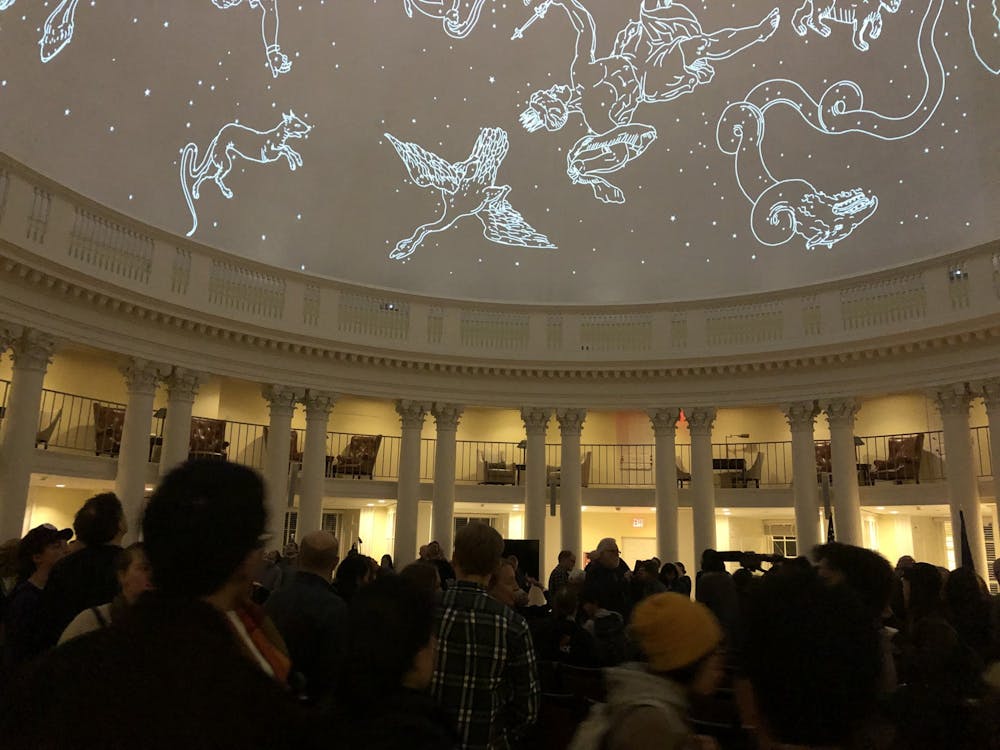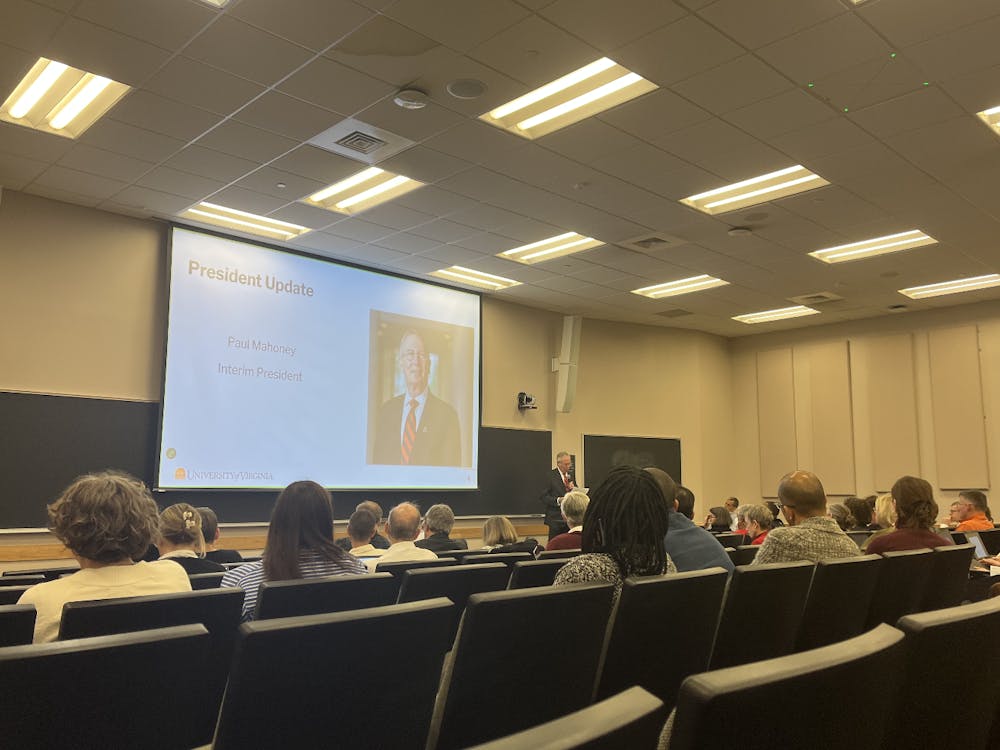Members of the University and Charlottesville community gathered at the Rotunda Friday evening to witness the unveiling of the Rotunda Planetarium. The planetarium is a tribute to Thomas Jefferson’s original vision for the purpose of the Rotunda. In addition, the installation attempts to remind people of the stories surrounding the Rotunda’s creation.
Since the Rotunda’s opening, its function and overall purpose has diminished — what was once a library, a museum and even a laboratory is now just a pretty sight.
However, graduate students Neal Curtis, Samuel Lemley and Madeline Zehnder — all Ph.D. candidates in the University’s English department — believe the Rotunda should serve a purpose on Grounds beyond its architectural prowess.
The three responded to this apparent decline in the Rotunda’s functionality by launching the Rotunda Planetarium project. As part of this project, constellations were projected on the ceiling of the Dome Room, and an exhibit was held to showcase a collection of rare and historical artifacts. These projections attracted both Charlottesville community members and University students with an estimated 160 people in attendance.
Although their goal Friday was to reveal the project that showcases constellations and exhibits artifacts, ultimately these students want to revive a sense of purpose and function to the Rotunda — to make it a space that students can actively use, rather than just visually admire.
“We hope to inspire other student groups or individuals at the University to view the Rotunda in a new way as something that should be put to use,” Lemley said. “There is this sense that the Rotunda is the mausoleum to Jefferson’s legacy, and it was so much more when it opened.”
The idea first came about while Curtis, Lemley and Zehnder were working together on a project about the history of the Rotunda Library. Their research involved sifting through books and artifacts in the archives and Special Collections Library. After stumbling upon Jefferson’s original design for the planetarium dome, they decided to recreate his vision. It just so happened that Jefferson’s drawings are dated in 1819, which makes its launch in 2019 the true bicentennial year for this design.
Spencer Hudec, an attendee at Friday’s launch and a staff member in the University’s Office of the Dean of Students, was thrilled to see Jefferson’s vision brought to life at the planetarium launch.
“I think it adds to the appeal [of the Rotunda] simply because it is realizing Jefferson's vision with new technology,” Hudec said. “This was a plan but he wasn't sure how to execute it … Technology finally caught up with his mind which is really neat.”
The project received financial support from a $30,000 grant from the Jefferson Trust, a program founded by the UVA Alumni Association to support community initiatives that reflect Jeffersonian values. Additional support included $2,000 from the Institute of the Humanities and Global Culture, in-kind donations from the Rare Book School and artifact donations from local collectors.
Most of the donations have gone towards the projection technology used to display constellations on the ceiling of the Rotunda dome. Five projectors were purchased, and the curators programmed each to turn on at sunset each night and to turn off when the Rotunda closes.
When asked about the accuracy of the constellation projection, Zehnder indicated that the projection was not intended to be scientifically accurate. Rather, the projection is intended to ignite curiosity regarding the functionality and history of the Rotunda as a space of living, learning and working.
“We have taken the images of the constellations that we've projected from an illustrated atlas, which was like state of the art science in the 18th century,” Zehnder said. “The oculus of the top of the dome prevents us from being able to show the whole hemisphere. We also wanted to draw people's attention to the textual sources for the image, to think about the space as something that was once a library.”
In order to provide context for the planetarium and deepen visitors’ knowledge of other objects of curiosity, the project also includes a series of exhibits in the glass cases of the Rotunda’s Dome Room. These exhibits, which showcase rare books and artifacts such as telescopes, are meant to restore one of the Rotunda’s original functions as a museum.
Curtis, Lemley and Zehnder collaborated with the Rare Book School to provide the case space for the museum exhibits. Curators from Special Collections Library and local collectors who donated exhibits were also instrumental in making the project technically possible.
To kick off Friday night’s launch event, Curtis, Lemley and Zehnder organized a panel entitled “The Rotunda, Revisited,” which was comprised of local scholars at the University. Panelists included four experts in the field of Jeffersonian architecture and the history of the Rotunda. Each speaker addressed the question of race within the University and the racial underpinnings of both the construction and usage of the Rotunda.
One panelist, Jalane Schmidt, an associate professor at the University’s department of religious studies, discussed how the Rotunda’s neoclassical design and overall presence maps race on Grounds. She cited a study conducted by Sophie Trawalter, an associate professor of public policy and psychology, which found that white students are much more likely to study in the Rotunda or sit on the Lawn than black students.
“In other words, that is another example of the Rotunda being the place that is comforting for white folks,” Schmidt said. “When I go into these spaces I often feel like an interloper.”
Schmidt explained that many black community members are reluctant to attend University functions held both on the Lawn or in the Rotunda due to its exploitative past.
“The University has been so exploitative for two centuries, and [black people] don’t feel like it's theirs,” Schmidt said.
Other panelists who spoke at the event included scholars Allison Bigelow, Max Edelson, Reed Gochberg, Ervin Jordan, Louis Nelson, Kirt von Daacke and Richard Guy Wilson.
Keynote speaker Sara J. Schechner — David P. Wheatland Curator of the Collection of Historical Scientific Instruments at Harvard University — emphasized the value of science and its influence on all aspects of life. Schechner said many scholars, such as Jefferson, believed that the workings of the natural world could be representative of the world of politics.
Curious individuals can check out the planetarium project for themselves, as it will remain active throughout the academic year. However, the artifacts in the cases must be returned to local collectors and will be replaced by new artifacts in February 2020. The projections have been programmed to start up automatically and remotely. The constellations will appear during student study hours Sunday through Tuesday from 5 p.m. to 10 p.m. in the Dome Room and during a series of public event nights, open to all members of the community.
The constellation projection portion of the project will continue running for a year, but Curtis, Lemley and Zehnder hope that other students and community members will continue to treat the Rotunda as a functional space. The curators will leave the projectors in the Dome Room, where they will be available to others who want to create art or other interesting visual projects.
“We’d like people to come and check it out and share their feedback with us,” Zehnder said. “We really are excited to keep the exhibit and the project evolving throughout the year, so student voices are very appreciated.”







